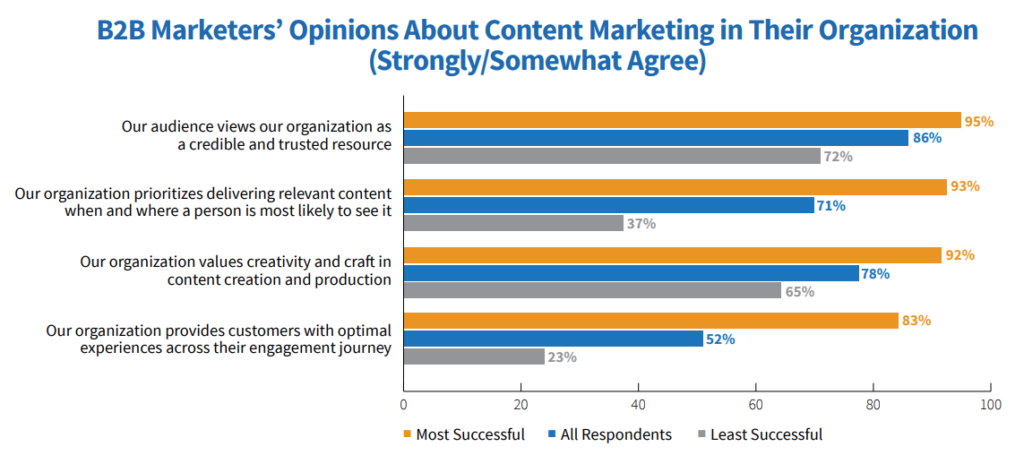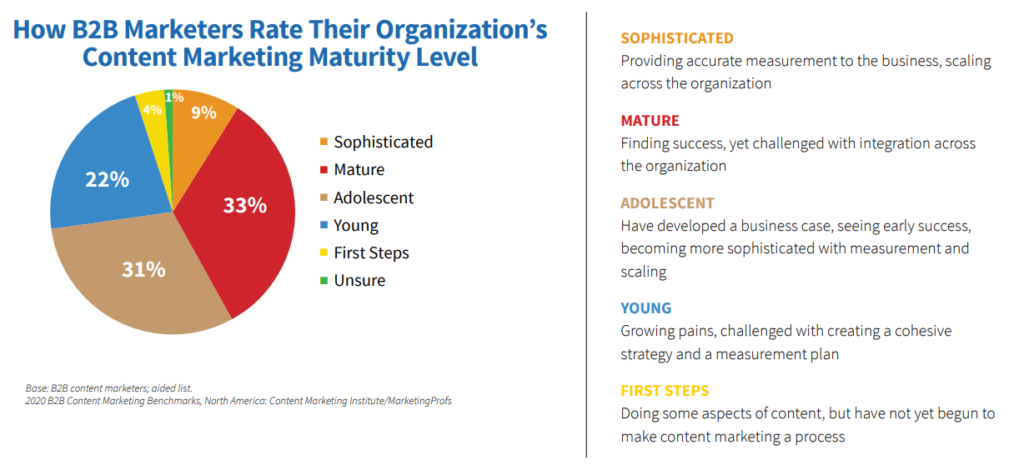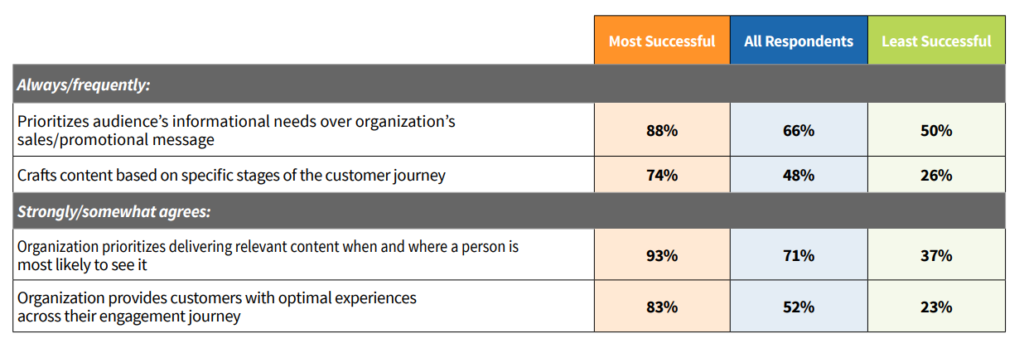
 Anyone who went to public school as a kid remembers Report Card Day. Sometimes, it was a day to celebrate — to see the results of our efforts written down in black and white, suitable for framing. Sometimes it was a sobering reminder of a misspent semester cutting class to browse the local CD shop (or was that just me?). I get the same vibe from the annual B2B Content Marketing Benchmarks, Budgets, and Trends - North America Report from Content Marking Institute (CMI) and MarketingProfs. We can rejoice in big improvements and gains. (More of us are documenting our content marketing strategy! Good for us!) And, of course, we can also see where we could benefit from study hall. If you find you're on the wrong side of these stats, there's good news. You don’t have to show this content marketing report card to your parents. No one’s getting grounded for underperforming. Better yet, the report is also a handy guide for improvement! So let’s take a look at some of the key takeaways that can help you move to the head of the class.
Anyone who went to public school as a kid remembers Report Card Day. Sometimes, it was a day to celebrate — to see the results of our efforts written down in black and white, suitable for framing. Sometimes it was a sobering reminder of a misspent semester cutting class to browse the local CD shop (or was that just me?). I get the same vibe from the annual B2B Content Marketing Benchmarks, Budgets, and Trends - North America Report from Content Marking Institute (CMI) and MarketingProfs. We can rejoice in big improvements and gains. (More of us are documenting our content marketing strategy! Good for us!) And, of course, we can also see where we could benefit from study hall. If you find you're on the wrong side of these stats, there's good news. You don’t have to show this content marketing report card to your parents. No one’s getting grounded for underperforming. Better yet, the report is also a handy guide for improvement! So let’s take a look at some of the key takeaways that can help you move to the head of the class.
B2B Content Marketing Opportunities for Improvement
 Unlike a report card, this report can actually help you improve your grade for next year. It highlights the inconsistencies between what we say we want, and what we’re actually doing. And it shows what the most effective marketers are doing differently.
Unlike a report card, this report can actually help you improve your grade for next year. It highlights the inconsistencies between what we say we want, and what we’re actually doing. And it shows what the most effective marketers are doing differently.
Opportunity Type 1: What We Say Versus What We Do
Are your content marketing practices consistent with your goals? If not, you’re not alone. Here are four opportunities for your team to stop working at cross purposes with itself. #1: Are You Building a Subscription Base? The vast majority of survey respondents (87%) agreed that email newsletters were the highest performing tactic for lead nurturing. Given marketers’ ever-pressing need to prove ROI and seamlessly get customers all the way through the funnel, that means we should be focusing on successfully building subscribers for those newsletters, right? However, less than half of respondents (45%) said their content marketing efforts were successful in building a subscribed audience. Top performers are doing better, but there's still a lot of opportunity — 68% have had success. While building a "subscribed audience" can certainly go beyond a traditional newsletter list (e.g. YouTube, blog RSS feeds, etc.), the email implications and opportunities are real. As my colleague Nick Nelson so elqouently stated in his recent post Email Marketing is NOT Dead, But It Needs Rejuvenation: "Email marketing is alive and well... This channel can still be a key fixture in your content strategy if you give it the care and attention it deserves." #2: Are You Creating Content for the Customer Journey? I will do my best not to lecture here. As a father of a 10-year-old and 4-year-old, lecturing is a reflex action, but I’ll do my best. But folks: Less than half of respondents said they’re creating content for specific stages in the customer journey. Only 48% are making it happen. [bctt tweet="New Report: Less than half of B2B marketers are creating content for specific stages in the customer journey. @CMIContent @MarketingProfs #B2BContentMarketing" username="toprank"] That means 52% are not guiding their audience to take logical next steps that lead to a sale. That means 52% are not actually doing content marketing. They’re just creating content. Content marketing requires knowing who your audience is, where you want them to go, and what steps they will need to take to get there. However, only 32% of respondents say they will prioritize getting to know their audience better in 2020. If you're not creating content beyond the top of the funnel, your homework is to take the time to gain deeper audience insights to develop a strategy for meeting your prospects and customers wherever they are in their journey. #3: Are You Using Your Budget Effectively (And Can You Prove It?) The content marketing gold rush of the early 00s is a distant memory. Nearly 40% of respondents said their content marketing budget would stay the same or decrease compared to last year. About a third said their budget would increase, but by less than 9%. I’m sure 100% of these respondents believe they could do better with a bigger budget. So why are the purse strings so tight? The best way to get more marketing budget is to show results from your existing budget. But only 43% said they measure content marketing ROI. And of that 43%, less than two-thirds said they were excellent or very good at measuring. [bctt tweet="New Report: Only 43% of B2B marketers say they measure content marketing ROI. @CMIContent @MarketingProfs #B2BContent Marketing" username="toprank"] Marketers need to elevate our profession by tying our efforts directly to revenue. We have the data and the tools to show the dollar value of every optimized blog post or influencer asset. Even top-of-funnel tactics can tie to ROI. [bctt tweet="Marketers need to elevate our profession by tying our efforts directly to revenue. @NiteWrites" username="toprank"] If you know your expected conversion rate for each stage of the funnel, and you can properly attribute those conversions, and you know the value of a sales-qualified lead, you can express your value directly in dollars and cents. Which, as we know, is the native language of the folks who sign off on budget proposals. Read: How to Rally Around ROI and Prioritize Your Digital Marketing Efforts in the Face of Budget Cuts #4: Are You Pursuing Sophistication? First, the good news: 69% of marketers say they are more successful now compared to one year ago. However, that perceived increase doesn’t correspond with an increase in sophistication. Only 9% say they’re truly sophisticated, with the ability to provide accurate measurement and scale across the organization. If your results are improving, but you’re not pursuing sophistication, those gains are likely to be temporary. Without the ability to scale, there’s a hard limit to what you can accomplish. Without the ability to measure ROI, your budget is likely to stagnate, even if you’re getting results. To keep growing your program, expanding and exploring new opportunities, even chasing a few shiny objects, it’s crucial to aim for increasing sophistication.
Opportunity Type 2: Borrowing from Top Performers
The other way to identify opportunities is to look at how tactics vary between the most successful and least successful respondents. What are these butt-kicking marketers doing that the rest of us haven’t picked up on yet? Here are four attributes of the most successful marketers that are the least common in the less successful.What Will Next Year’s Report Card Look Like?
If you felt nervous looking at the B2B Content Marketing Benchmarks this year, now’s the time to start planning for next year. Invest in closing the opportunity gaps in your marketing efforts, increase your audience knowledge, pursue sophistication, and measure, measure, measure. With a more strategic outlook (and a documented content marketing strategy — can’t stress that enough) you can anticipate the 2021 benchmark report with the serene confidence of a 4.0 student. Tighten up your core marketing strategy with advice and insights from some of the industry's best and brightest. Check out our interactive B2B Marketing Fitness eBook featuring 16 B2B marketers.
The post Class Is In Session: 8 Opportunities From the 2020 B2B Content Marketing Benchmarks Report appeared first on Online Marketing Blog - TopRank®.
from Online Marketing Blog – TopRank® https://ift.tt/2MEb7y1
via IFTTT

